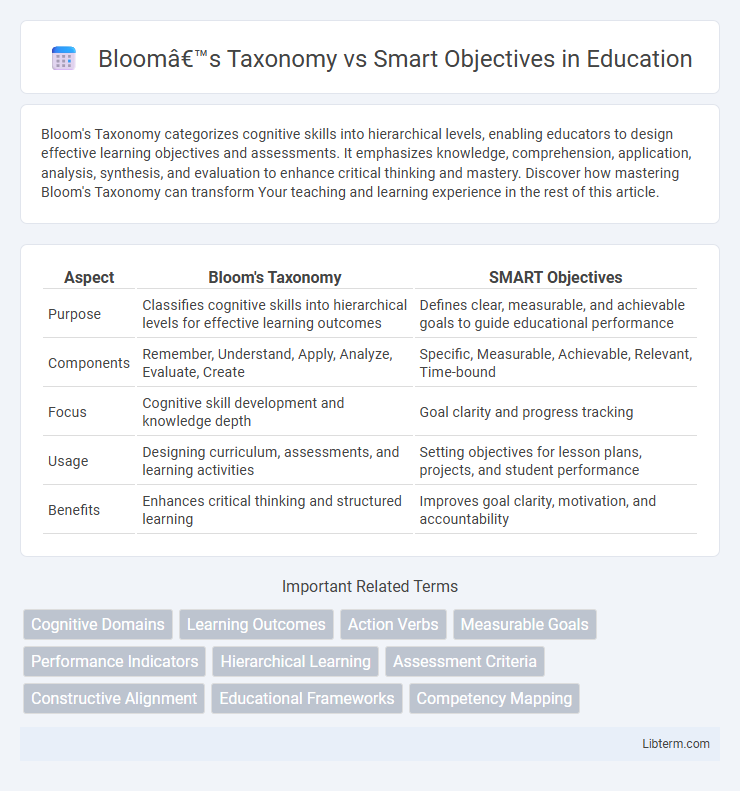Bloom's Taxonomy categorizes cognitive skills into hierarchical levels, enabling educators to design effective learning objectives and assessments. It emphasizes knowledge, comprehension, application, analysis, synthesis, and evaluation to enhance critical thinking and mastery. Discover how mastering Bloom's Taxonomy can transform Your teaching and learning experience in the rest of this article.
Table of Comparison
| Aspect | Bloom's Taxonomy | SMART Objectives |
|---|---|---|
| Purpose | Classifies cognitive skills into hierarchical levels for effective learning outcomes | Defines clear, measurable, and achievable goals to guide educational performance |
| Components | Remember, Understand, Apply, Analyze, Evaluate, Create | Specific, Measurable, Achievable, Relevant, Time-bound |
| Focus | Cognitive skill development and knowledge depth | Goal clarity and progress tracking |
| Usage | Designing curriculum, assessments, and learning activities | Setting objectives for lesson plans, projects, and student performance |
| Benefits | Enhances critical thinking and structured learning | Improves goal clarity, motivation, and accountability |
Defining Bloom’s Taxonomy
Bloom's Taxonomy is a hierarchical classification of cognitive skills used to structure educational objectives, encompassing six levels: Remembering, Understanding, Applying, Analyzing, Evaluating, and Creating. It provides educators with a framework to design curriculum, assessments, and learning activities that promote higher-order thinking skills. This taxonomy contrasts with SMART objectives, which emphasize specific, measurable, achievable, relevant, and time-bound goals for clear performance expectations.
What Are SMART Objectives?
SMART objectives are specific, measurable, achievable, relevant, and time-bound goals designed to provide clear direction and criteria for success. They enable precise tracking of progress and ensure objectives are realistic and aligned with broader business or educational aims. Unlike Bloom's Taxonomy, which categorizes cognitive skills, SMART objectives focus on the practical formulation and execution of actionable targets.
Key Differences Between Bloom’s Taxonomy and SMART Objectives
Bloom's Taxonomy categorizes cognitive skills into hierarchical levels--Remembering, Understanding, Applying, Analyzing, Evaluating, and Creating--guiding educators in designing educational goals based on cognitive complexity. SMART Objectives focus on crafting Specific, Measurable, Achievable, Relevant, and Time-bound goals to ensure clear, actionable outcomes in educational and professional settings. The key difference lies in Bloom's emphasis on cognitive developmental stages, while SMART Objectives prioritize concrete goal-setting criteria for tracking progress and success.
Purpose and Application in Education
Bloom's Taxonomy serves as a hierarchical framework categorizing cognitive skills to guide curriculum development and assessment design, focusing on fostering higher-order thinking from remembering to creating. Smart Objectives are precise, measurable goals that enhance lesson planning and student performance tracking by specifying criteria such as Specificity, Measurability, Achievability, Relevance, and Time-bound targets. Combining Bloom's Taxonomy with Smart Objectives supports educators in setting clear, targeted learning outcomes while promoting critical thinking and skill mastery across diverse educational contexts.
Structuring Learning Goals: Bloom’s vs SMART
Bloom's Taxonomy structures learning goals by categorizing cognitive skills into six hierarchical levels: Remembering, Understanding, Applying, Analyzing, Evaluating, and Creating, which helps educators design objectives that promote deeper learning. SMART Objectives emphasize specificity, measurability, attainability, relevance, and time-bound criteria, ensuring clear, actionable, and assessable goals. Integrating Bloom's cognitive levels with SMART criteria allows for precisely framed learning goals that enhance both educational depth and practical assessment.
Measuring Learning Outcomes
Bloom's Taxonomy categorizes learning outcomes into cognitive levels such as remembering, understanding, applying, analyzing, evaluating, and creating, facilitating precise measurement of student progress. SMART objectives offer specific, measurable, achievable, relevant, and time-bound criteria that define clear benchmarks for assessing learning achievements. Combining Bloom's hierarchical framework with SMART criteria enhances the clarity and effectiveness of measuring educational goals across diverse learning domains.
Integrating Both Models in Curriculum Design
Integrating Bloom's Taxonomy with SMART objectives enhances curriculum design by aligning specific, measurable goals with cognitive skill development levels, fostering clear learning outcomes. Educators can map SMART objectives to Bloom's hierarchical domains, ensuring that each objective targets knowledge acquisition, comprehension, application, analysis, synthesis, or evaluation. This approach promotes structured lesson planning, improves assessment accuracy, and facilitates student progress tracking through quantifiable and cognitively robust learning targets.
Advantages and Limitations of Each Approach
Bloom's Taxonomy provides a structured framework for categorizing educational objectives, enhancing cognitive skill development from basic recall to higher-order thinking, but may lack specificity in measurable outcomes. SMART objectives offer clear, actionable, and measurable goals that facilitate precise evaluation and accountability, although they might oversimplify complex learning processes and limit creativity. Combining Bloom's hierarchical cognitive levels with SMART criteria can optimize instructional design by balancing depth of understanding with clarity and measurability.
Practical Examples: Bloom’s Taxonomy vs SMART Objectives
Bloom's Taxonomy categorizes cognitive skills from remembering to creating, using verbs like "analyze" and "evaluate" to structure learning outcomes, such as asking students to compare historical events. SMART Objectives define specific, measurable, achievable, relevant, and time-bound goals, like increasing sales by 10% within three months. Practical application involves designing a lesson where Bloom's verbs guide tasks, while SMART criteria set clear targets for student performance and assessment timelines.
Choosing the Right Framework for Your Learning Environment
Selecting the appropriate framework between Bloom's Taxonomy and SMART objectives depends on the learning environment's goals and assessment criteria. Bloom's Taxonomy emphasizes cognitive skill development through hierarchical levels, ideal for designing curriculum that targets critical thinking and knowledge mastery. SMART objectives provide specific, measurable, achievable, relevant, and time-bound goals, perfect for performance tracking and outcome-based education in structured learning settings.
Bloom’s Taxonomy Infographic

 libterm.com
libterm.com